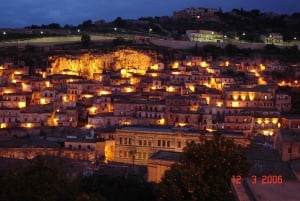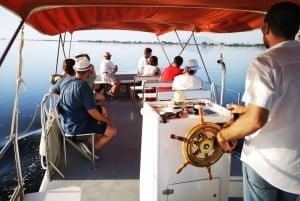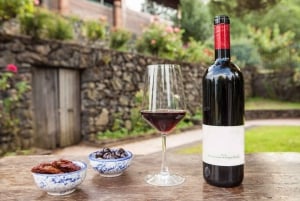Wines of Sicily and Their History
An oenologist once said: "Sicilian wines encompass the essence and spirit of 20 civilizations." We don't know if 20 nations are responsible for the Sicilian wines of today, but sure quite a number.
According to legend, it was Dionysus, the God of Wine, who planted dancing the first: grapevine in Giardini-Naxos. Before the arrival of the old Greeks, grapes were not cultivated in Sicily. They introduced the form of growing vines low to the ground as bushes (known as "alberello" - what means "small tree"), which is still used today in windy and dry areas. And they brought their knowlegde of pruning and selection to the island.
Under the Romans the wine production was increased and Sicilian wines were exported to the Roman eastern dominions, to Gaul (today France), and Roman territories that are today Germany and Spain. During the Byzantine period, two thirds of Sicily came under control of the Christian Church which innovated and improved the Sicilian vitiulture. The wine production decreased under the Arabs, although they increased the production of table grapes - but they were not used to produce wine, they were dried. Normans and Swabians picked up again, but it was under the Spanish that the interest in Sicilian wines was really revived and exports started again. It was due to the Aragonese, who ruled Sicily for more than 200 years, that Sicily's economy prospered. Wines had a very high alcohol content and were used to blend with wines from other regions. The original areas of production are to be found in the west of Sicily, around the towns of Alcamo, Castelvetrano and Castellammare del Golfo, and in the east around Vittoria and Avola. Trapani is still the largest wine production area of the island.
The sweet Marsala wine was incvented by the British merchant John Woodhouse who was supposed to buy soda in Trapani in the year 1773. He did not make it to Trapani because a tempest forced his ship to seek shelter in the port of Marsala. He went ashore in this quiet and a bit sleepy town and passed the waiting time in a taverna where he “stumbled” across the local wine which he thought was as good as the Port and Madeira wine the British had long imported from Portugal, and which were very popular at his time in England. He skipped the soda and began thinking of how this wine he liked so much was to survive the long passage to England. He fortified the local wine with alcohol and sent some barrels home to his partner. It proved as successful as he had wished for – the famous Marsala wine was born! Mr. Woodhouse returned to Sicily to stay and in the year 1796 the Baglio Woodhouse opened, beginning the commercialization and mass production of this wine.
The Duke of Salaparuta marketed the first bottled wine of Sicily and founded the house of the same name in 1824 - which is still existing.
An aphid brought to Sicily on vines bought from France caused a crisis in 1880 and 1881 and had a devastating effect on the wine production all over Sicily. It took more than 70 years for the complete replacing with vines resistant to the phylloxera-aphid. In the 1950s the mechanisation of vineyards started. This conicided with a fall in demand for wines for blending and the timing of the grape harvest with the aim of producing wine with a lower alcohol content started. New technologies were introduced in the 1970s, which improved the quality of the white Sicilian wines. Sicily had always relied on quantity, but the pressure of the market in the 1990s meant that Sicilian wines needed to justify their place in the market on the basis of quality, not quantity. Enormous investments in the Sicilian wine industry were made, with public bodies and private investors working side by side. New techniques were being studied and previously undervalued grape varieties were re-introduced, not to mention the expansion of the area of land suitable for the growing of vines.
Sicily now grows many international grape varieties, there are some varieties which, because of Sicily's climate are to be found almost exclusively here.
The landscape of Sicilian Wine
Together with Puglia, Sicily is now the largest producer of Italian wine in Italy. Wine accounts for more than 15% of Sicily's agricultural production. Although 70% of wine produced in Sicily is white, it is its reds that are causing an international stir. 15 Sicilian wines were being awarded the prestigious Three Glasses in 2005. Most of the 19 DOC wine areas in Sicily are concentrated in the Val di Mazara. However, the south-east produces some excellent wines, with many of the better known names of grape varieties coming from this area, hence the Frappato di Vittoria and the Nero d'Avola.
The islands of Pantelleria, Lipari and Salina (Aeolian Islands) produce some wonderful sweet wines. The area around Mount Etna with its unique microclimate is another important area of production. The variety of topologies that make up Sicily and the different characteristic weather patterns which are then created mean that a huge variety of wines can be produced within a relatively small area. Many agriturismos on Sicily boast their own vineyard. The high-altitude of some Sicilian vineyards creates climatic conditions similar to northern regions, with the advantage of much more sun.
Overall the predominant climate is hot and dry which results in characteristically robust and powerful wines. Wine-making is generally accepted to be more simple in the south, where problems with hail and excessive rain are much rarer. The lack of water also means that there is less need for intervention against moulds and diseases that attack the vines. This lack of water means that, despite the hardiness of the vines, tannins in the grapes are much more liable to mature while the grapes are still on the vine.
White Vines
Catarratto is found mainly in the area around Trapani. It is rarely found on its own and often blended with other varieties to give more structure and interest to the wine.
Carricante - found exclusively around Mount Etna and has been there for centuries. It is one of the bases for the DOC Etna Bianco Superiore.
Grecanico is probably of Greek origin. It grows very well in the area around Trapani as it can withstand the brackish winds common to the area.
Grillo has been introduced from Puglia in 1897 after the devastation caused by the phylloxera. It produces wines with a relatively high alcohol content and is one of the bases used for good Marsala.
Inzolia/Ansonica is said to be of Greek origin and mainly found in the west of Sicily, where it produces fresh, structured and intense wines.
Malvasia di Lipari grows only on the Aeolian islands, mainly on Salina -it was probably introduced by the Greeks in the5th century BC. It forms the base of the sweet wine of the same name.
Moscato Bianco is a very old variety cultivated all over the Mediteranean and used to produce both the DOC Moscato di Noto and DOC Moscato di Siracusa. Production of both is limited due to the difficulties created by the effects of climate and the techniques that must be used to produce the wine.
Moscato di Alessandria - Zibbibo is probably of Egyptian origin and was introduced to Sicily by the Romans. It is exclusively to be found on Pantelleria and the arid conditions mean that production is severly limited.
Red Vines
Frappato (di Vittoria) - first records of this variety date from the 17th century, but there is an argument as to whether it is indigenous or was introduced by the Spanish. It is one of the bases for the Cerasuolo di Vittoria.
Perricone/Pignatello is known by these two names in Palermo and Trapani. It is often mixed with the Nero d'Avola to give wines a more interesting structure.
Nerello Cappuccio/Mantellato - of unknown origin, grows mainly in the province of Messina and is often blended with the Nerello Mascalese to increase the longevity of the wine.
Nerello Mascalese is very different to the Nerello Cappuccio. It has been present on the slopes of Etna and around Mascali for at least 400 years.
Nero d'Avola/Calabrese is the most commonly grown red grape in Sicily, found in the provinces of Agrigento, Siracusa, Caltanissetta and Ragusa. It is often blended with Frappato and Cabernet Sauvignon. According to the "Gambero Rosso" it is now the most sought-after red in Italy.
Sweet Wines
Sicily produces some excellent sweet wines, of which the most famous is the Moscato di Pantelleria, made from Zibbibo, and the Moscato di Siracusa, made from the white Muscat grape. The sweet Malvasia wine is produced on the island of Lipari.
Marsala can be an aperitif or a digestif and is a fortified wine or aged like a Solera Sherry. The first Italian house to produce Marsala was Florio who bought out Woodhouse, but maintained quality. Pellegrino was established in 1880 and produces excellent quality Marsala. In 1963 DOC regulations were introduced to control Marsala and ensure quality. It can either be dry, semi-dry or sweet but the main denomination is relative to the amount of time it has had to mature, from one to ten years and more. It is made from grapes with a high natural sugar content, Grillo, Catarratto and Inzolia. It forms the base of zabaglione and is used in many Sicilian recipes
The Houses of Sicilian Wine
There are now many excellent, world-class wines being produced in Sicily and this is a very exciting period of experimentation and expansion. The majority of Sicilian houses are still owned and run by the founding families. Many of them, for example Firriato and Calatrasi, are working alongside agronomical experts and oenologues from all over the wine-making worlds, both old and new. Producers from other parts of Italy, looking to increase their range of wines, have also moved into Sicily. Feudo Arancio, for example, which is produced in the area around Agrigento, is owned and controlled by a co-operative from Trentino-Alto Adige.











